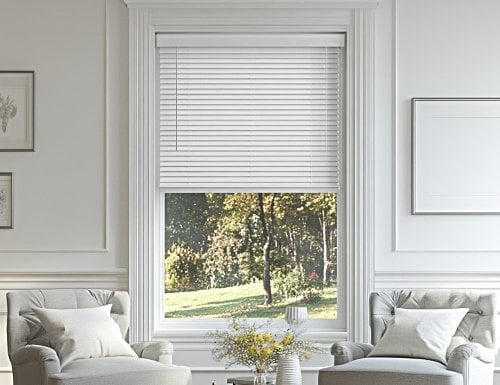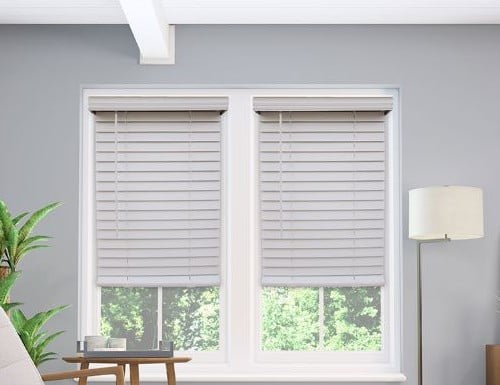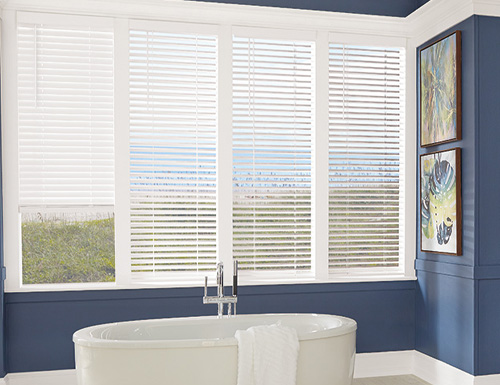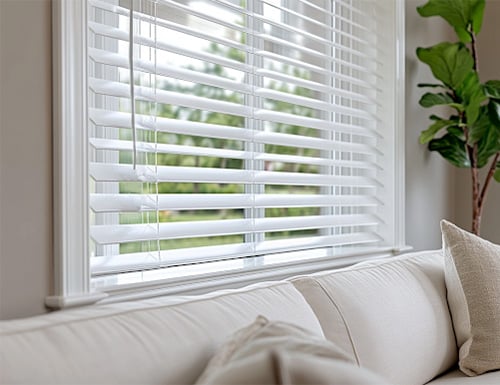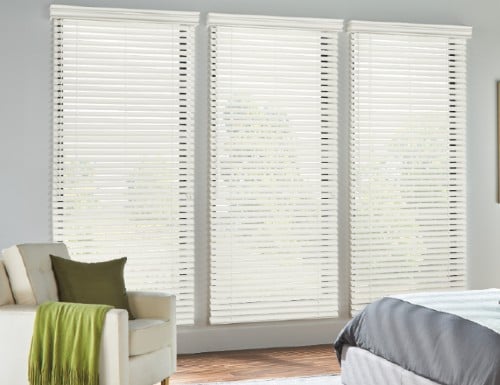Lexi Westingate | Blinds Chalet Design Team
Updated: Sep 13 2024

Selecting the ideal window treatments can be a tough decision, especially when weighing the beauty of natural wood against the practicality of synthetic alternatives. Both faux wood and real wood blinds bring their own advantages, but which one fits your home best? This detailed comparison will help you assess the strengths of each option so you can make a decision that aligns with your personal style, needs, and budget.
1. Aesthetic Appeal: Genuine Warmth vs. Realistic Imitation
Real Wood Blinds:
If you’re after an authentic, natural look, real wood blinds are the gold standard. Each slat is crafted from natural wood, offering a unique grain pattern that adds richness and warmth to any space. Whether your style is traditional, rustic, or even modern, real wood blinds lend a timeless appeal.
- Natural Texture: Real wood blinds provide a level of organic beauty that synthetic options can’t fully replicate. The variation in texture gives each set of blinds its own character.
- Finish Variety: Available in a wide array of stains and finishes, real wood blinds can easily be matched to your home’s color scheme.
Faux Wood Blinds:
Thanks to modern manufacturing techniques, faux wood blinds have become excellent look-alikes for real wood. They are made from durable materials like PVC or composite and offer a similar aesthetic at a more affordable price point.
- Realistic Appearance: Faux wood blinds can closely mimic the appearance of real wood, especially when viewed from a distance.
- Custom Color Options: Faux wood blinds come in a range of finishes, from light woods to deeper, more dramatic shades, allowing for easy customization.
Which is Better for Aesthetics?
For those who prefer the authentic beauty and warmth of natural materials, real wood blinds are the clear winner. However, if you want to balance style and affordability, faux wood blinds are a fantastic alternative, offering a similar look for less.
2. Durability: Natural Sturdiness vs. Weather Resistance
Real Wood Blinds:
While real wood blinds are strong and durable, they are more sensitive to environmental factors like humidity and sunlight, which can cause them to warp or fade over time. This makes them less ideal for rooms with moisture, such as kitchens or bathrooms.
- Moisture Sensitivity: Real wood can absorb moisture, causing it to swell, warp, or crack in humid environments.
- Sunlight Fading: Prolonged exposure to direct sunlight can lead to fading or discoloration, requiring extra maintenance.
Faux Wood Blinds:
Faux wood blinds are designed to withstand harsh conditions, such as high humidity or heavy sunlight. These blinds are ideal for bathrooms, kitchens, or any room with extreme conditions, as they won't warp or discolor over time.
- Moisture-Resistant: Perfect for high-humidity spaces, faux wood blinds won’t swell or crack when exposed to moisture.
- Sun-Resistant: These blinds retain their color and shape even after long-term exposure to sunlight.
Which is Better for Durability?
Faux wood blinds are a superior choice for rooms with high humidity or direct sunlight exposure. Their resistance to warping, cracking, and fading makes them a longer-lasting option compared to real wood.
3. Maintenance: High Upkeep vs. Low Maintenance
Real Wood Blinds:
Real wood blinds require more care to maintain their beauty. They need regular dusting, polishing, and protection from excessive moisture to prevent damage. While the effort may be worthwhile for those who prioritize natural materials, upkeep can be time-consuming.
- Polishing Required: To keep real wood blinds in top shape, they should be polished occasionally.
- Avoid Humidity: Extra care must be taken to avoid moisture damage.
Faux Wood Blinds:
Faux wood blinds are easier to maintain, as they are non-porous and resistant to stains and dust.
A quick wipe with a damp cloth is all that’s needed to keep them looking fresh.
- Minimal Maintenance: Faux wood blinds are a breeze to clean—no polishing or special treatments required.
- Stain-Resistant: These blinds won’t absorb stains, making them ideal for high-traffic areas like kitchens.
Which is Better for Maintenance?
Faux wood blinds are the clear winner when it comes to maintenance. They require very little upkeep, making them a perfect option for busy households or anyone looking for hassle-free blinds.
4. Cost: Higher Investment vs. Budget-Friendly Option
Real Wood Blinds:
Real wood blinds are typically more expensive due to the cost of natural materials and the craftsmanship required. However, their premium look and feel can add value to your home, making them a worthwhile investment if you’re willing to pay more upfront.
- Luxurious Look: The aesthetic appeal of real wood blinds is undeniable, but it comes with a higher price tag.
- Investment in Quality: Real wood blinds are often viewed as a long-term investment due to their premium quality and timeless appeal.
Faux Wood Blinds:
If you’re looking for a more cost-effective option, faux wood blinds provide the appearance of real wood at a fraction of the price. They’re ideal for homeowners who want to outfit multiple rooms without breaking the bank.
- Affordable Style: Faux wood blinds offer a budget-friendly alternative that doesn’t sacrifice style.
- Customization Without the Premium: Custom faux wood blinds can fit your windows perfectly without the higher costs associated with real wood.
Which is Better for Cost?
Faux wood blinds are the best option for those seeking a stylish, affordable solution. If you’re willing to invest more for the authentic look and feel of natural wood, real wood blinds could be worth the additional cost.
5. Environmental Impact: Natural Materials vs. Longevity
Real Wood Blinds:
Made from renewable resources, real wood blinds can be sustainably sourced and are biodegradable, making them a good choice for eco-conscious consumers. However, wood harvesting does have an environmental impact, so it’s important to choose blinds from responsibly managed forests.
- Sustainability: Look for options made from sustainably harvested wood.
- Biodegradable: Real wood blinds can naturally decompose, which is a plus for the environment.
Faux Wood Blinds:
Although faux wood blinds are made from synthetic materials, their longer lifespan can reduce waste, as they won’t need to be replaced as frequently as real wood blinds. By choosing faux wood, you can also reduce the demand for natural wood products.
- Long-Lasting: Faux wood blinds tend to last longer in challenging environments, reducing the need for replacements.
- Conservation of Natural Resources: Opting for faux wood helps conserve forests by reducing the demand for wood products.
Which is Better for the Environment?
If environmental sustainability is your priority, real wood blinds from responsibly sourced
materials are a great option. However, faux wood blinds offer a more durable and long-lasting
solution, which can help minimize environmental waste over time.
Conclusion: Finding the Perfect Blinds for Your Home
Ultimately, the best choice between faux wood and real wood blinds comes down to your specific needs. Real wood blinds offer unparalleled natural beauty and a high-end aesthetic but require more maintenance and may not be ideal for humid environments. Faux wood blinds, on the other hand, provide excellent durability, moisture resistance, and affordability, making them a versatile choice for any home.
Browse BlindsChalet.com to explore our wide selection of faux wood and real wood blinds. Whether you’re looking for the elegance of natural wood or the practicality of faux, we have the perfect solution to match your style and budget.





